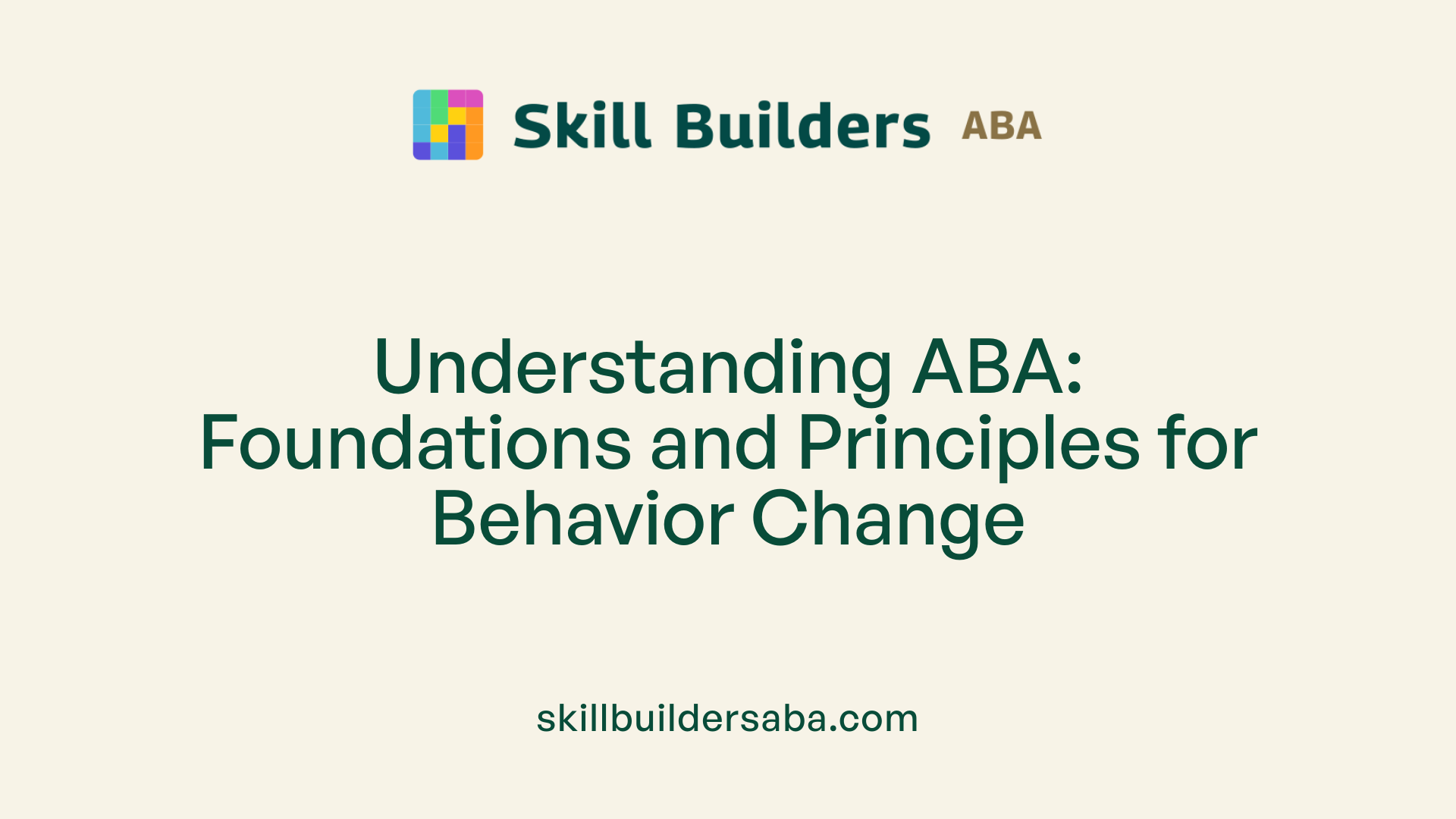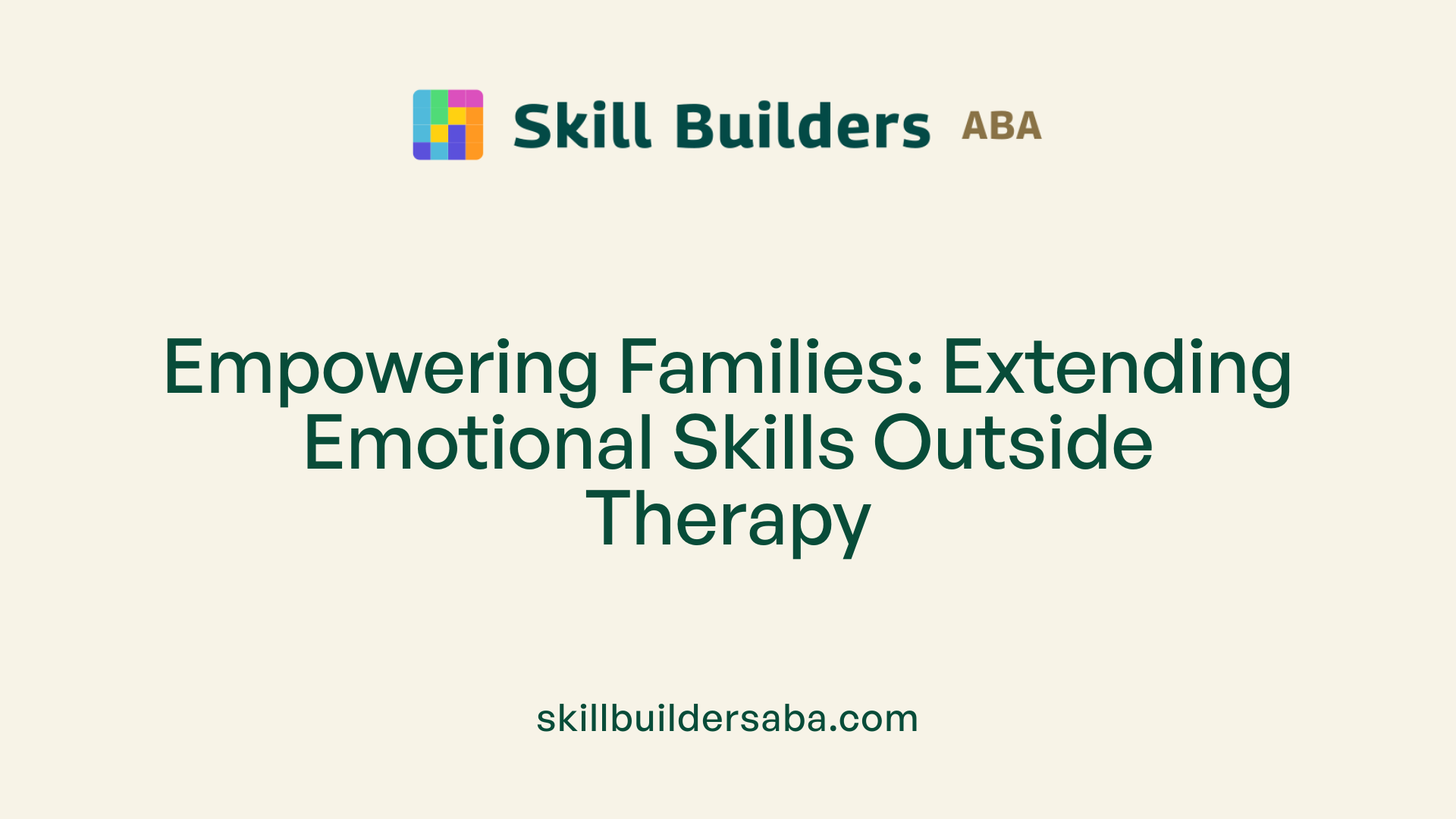Using ABA to build emotional vocabulary
Understanding the Role of ABA Therapy in Enhancing Emotional Expression

Introduction to ABA and Emotional Development
Applied Behavior Analysis (ABA) therapy is widely recognized for its effectiveness in supporting children with autism spectrum disorders (ASD) to develop key life skills. One critical area that ABA targets is the building of emotional vocabulary and communication—a fundamental component of social and emotional development. This article explores how ABA therapy helps children understand, express, and respond to emotions by fostering their communication abilities and social skills, empowering them to navigate their emotional world with greater confidence and independence.
Foundations of ABA Therapy and Its Approach to Behavior Change

What is applied behavior analysis (ABA) therapy?
Applied Behavior Analysis (ABA) therapy is a science-based approach that helps children with autism spectrum disorder (ASD) learn new skills and improve behaviors that are essential for daily living. It focuses on how environmental factors influence behavior and applies learning principles to encourage positive changes.
Scientific basis and evidence-based nature
ABA therapy is grounded in decades of research showing its effectiveness. Major health organizations recognize ABA as an evidence-based intervention that has been proven to enhance intellectual, language, and social skills in children when applied with intensity and consistency.
Use of positive reinforcement and behavior modification techniques
A main strategy in ABA is positive reinforcement. This means rewarding desired behaviors to make them more likely to happen again. Techniques like prompting, shaping, and functional assessments are used to customize approaches. Specific methods such as Discrete Trial Training (DTT) break down skills into manageable steps, while Pivotal Response Training (PRT) integrates learning through play and real-life contexts.
Individualized treatment plans by BCBAs
Experienced Board Certified Behavior Analysts (BCBAs) develop personalized plans tailored to each child’s unique strengths and challenges. These treatment plans target key areas like communication, social skills, and daily living, focusing on promoting independence and meaningful skill development.
| Aspect | Description | Details |
|---|---|---|
| Definition | ABA is a scientific method to improve behaviors by understanding learning principles | Includes techniques like positive reinforcement and discrete trials |
| Evidence-base | Proven effective through research and recognized by health authorities | Used intensively over time for lasting gains |
| Techniques | Positive reinforcement, prompting, shaping, functional behavioral assessments | DTT, PRT, and Early Start Denver Model used to teach specific skills |
| Treatment personalization | Customized by BCBAs for each child’s needs | Targets communication, social interaction, and independence |
How ABA Therapy Facilitates Emotional Vocabulary Development
How does ABA therapy benefit individuals with autism?
ABA therapy supports children with autism by enhancing vital life and communication skills. It uses positive reinforcement—a method where rewarding certain behaviors increases the chance they will be repeated—to promote lasting behavior changes. This individualized approach addresses each child's unique strengths and challenges and works in settings like home, school, and community, making social interactions, communication, and self-care easier and more independent.
Development of expressive and receptive language skills
ABA therapy targets both expressive language (the ability to share thoughts and feelings through words and sentences) and receptive language (understanding spoken words, gestures, and non-verbal cues). Building these skills helps children communicate clearly and understand others better.
Use of visual aids, play-based therapy, and social scenarios
Visual aids such as pictures and symbols, along with play-based therapy, are commonly used to expand vocabulary and communication abilities. Social scenarios provide real-life practice, making the learning process engaging and meaningful.
Discrete Trial Training (DTT) and Pivotal Response Training (PRT) techniques
Techniques like Discrete Trial Training (DTT) break skills into small, manageable steps in a structured and repetitive way, helping children master specific language components. Pivotal Response Training (PRT) complements this by incorporating play and natural interactions, encouraging motivation and generalization of skills including emotional and social communication.
Teaching sentence structure and social communication skills
ABA therapy focuses on teaching children sentence structure to enable more independent communication. It also fosters social communication skills that help children initiate and maintain conversations, improving their ability to connect with others and participate in social contexts.
Improving understanding of verbal and non-verbal cues
Teaching receptive communication involves helping children understand not only verbal instructions but also non-verbal signals like body language and facial expressions. Enhanced listening and interpretation skills gained through ABA improve engagement and independence, especially in social and educational settings.
Roles and Qualifications of ABA Therapy Providers

Who Typically Provides ABA Therapy and What Qualifications Do They Have?
ABA therapy is delivered by trained professionals with specific credentials to ensure effective intervention for children with autism spectrum disorders. The main providers include Board Certified Behavior Analysts (BCBAs) and Registered Behavior Technicians (RBTs).
Board Certified Behavior Analysts (BCBAs) and Registered Behavior Technicians (RBTs)
BCBAs are graduate-level professionals who design and oversee personalized ABA treatment plans. They complete extensive supervised fieldwork and pass a rigorous certification exam to demonstrate expertise in behavioral analysis and autism interventions. RBTs are certified paraprofessionals who work directly with children implementing therapy programs under the supervision of BCBAs. To become RBTs, individuals must complete specialized training and pass a competency assessment.
Professional Training and Certification Requirements
BCBAs require advanced degrees in behavior analysis or related fields, substantial practicum experience, and certification through the Behavior Analyst Certification Board (BACB). RBTs must complete a standardized training course and competency evaluation to qualify. Other licensed therapists such as speech-language pathologists or occupational therapists may incorporate ABA techniques if they have completed relevant training.
Importance of Qualified Providers for Effective Intervention
Qualified providers are essential for delivering evidence-based ABA therapy tailored to each child’s needs. BCBAs ensure that programs are scientifically grounded, continuously monitored, and adjusted for maximum benefit. RBTs provide consistent, hands-on implementation of therapy strategies.
Collaboration With Multidisciplinary Teams
ABA therapists often work closely with speech therapists, occupational therapists, and educational professionals to address the wide range of developmental needs in children with autism. This team approach promotes comprehensive support, ensuring communication, social skills, and daily living abilities grow in harmony.
| Provider Role | Qualifications | Responsibilities |
|---|---|---|
| Board Certified Behavior Analyst (BCBA) | Graduate degree, BACB certification, supervised fieldwork | Designs, supervises, and adjusts individualized ABA programs |
| Registered Behavior Technician (RBT) | Specialized training, competency assessment | Implements ABA therapy directly under BCBA supervision |
| Licensed Therapists (e.g., Speech, Occupational) | Relevant licensure and ABA training | Incorporates ABA methods into broader therapeutic services |
Structure and Dynamics of ABA Therapy Sessions Focused on Emotional Skills
What does an ABA therapy session usually involve?
An ABA therapy session typically begins with an initial assessment tailored to each child's unique needs. This assessment often incorporates play-based activities and data collection that help the Board Certified Behavior Analyst (BCBA) design a personalized treatment plan focused on specific goals.
How are positive reinforcement and child-centered engagement used?
The session environment prioritizes building trust and comfort. Therapists utilize positive reinforcement to encourage desired behaviors, ensuring that the child feels motivated and secure throughout the therapy. This child-centered approach enhances engagement and promotes consistent participation.
What structured and play-based methodologies are applied?
Therapists apply evidence-based techniques such as Discrete Trial Training (DTT), which breaks down skills into small, manageable steps in a repetitive and structured manner. They may also use Pivotal Response Training (PRT), which incorporates play and real-life scenarios to teach essential social and emotional skills. These methods work together to nurture emotional communication effectively.
How is parent involvement and coaching integrated?
Parent involvement is a vital component of ABA sessions. Parents often observe and participate during therapy to learn strategies that they can reinforce at home and in community settings. This coaching helps generalize emotional communication skills beyond the therapy environment, creating consistency across daily life.
How is measurable progress in emotional communication tracked?
Throughout the sessions, therapists carefully track progress using measurable objectives aligned with the child's goals. Data collection enables ongoing adjustments to the treatment plan to optimize outcomes in social interaction, emotional regulation, and communication abilities.
| Session Step | Description | Purpose |
|---|---|---|
| Initial Assessment | Play-based evaluation and data gathering | Personalized goal setting |
| Positive Reinforcement Setup | Creating a welcoming, supportive atmosphere | Enhancing motivation and trust |
| Skill Instruction | Using DTT, PRT, or incidental teaching techniques | Teaching emotional and social skills |
| Parent Coaching | Training parents to apply ABA strategies at home | Promoting skill generalization |
| Progress Monitoring | Recording data and reviewing goals regularly | Adjusting therapy for sustained growth |
Suitability and Ethical Considerations of ABA Therapy for Emotional Growth
Is ABA therapy suitable for all individuals with autism?
ABA therapy is a well-established, evidence-based approach that can support skill development and emotional growth in many children with autism when customized to their unique needs. However, its appropriateness varies widely among individuals with autism spectrum disorders due to differences in developmental profiles, behavioral challenges, and personal preferences.
A comprehensive assessment by Board Certified Behavior Analysts and other professionals helps determine if ABA suits the individual’s specific circumstances. The therapy emphasizes personalized plans, addressing strengths and challenges, making it flexible for various ages and needs. Integration with other therapies like speech and occupational therapy often enhances outcomes by addressing multiple developmental domains simultaneously. Collaborating closely with families and educators promotes consistency across home, school, and community settings.
What are some criticisms or concerns related to ABA therapy?
Criticism of ABA arises mainly from concerns about its potential rigidity and focus on normalizing autistic behaviors, which some feel may conflict with the acceptance of neurodiversity. Early ABA approaches occasionally applied aversive techniques, raising ethical issues about autonomy and dignity. Today, ethical guidelines emphasize positive reinforcement, naturalistic and person-centered methods, and respect for individual differences.
Some critics worry that despite modernization, ABA might still prioritize behavior conformity over emotional well-being, challenging bioethical principles like justice and nonmaleficence. Resource constraints, particularly in underserved regions, can also impact the delivery of high-quality, individualized treatment, causing disparities in access and quality.
Importance of person-centered and naturalistic approaches
Modern ABA encourages naturalistic teaching methods and embraces child-led interactions, which align with respect for emotional development and self-expression. Approaches such as the Early Start Denver Model blend play-based learning with structured interventions, supporting not only communication and daily skills but also emotional and social engagement.
Ultimately, determining ABA therapy’s suitability involves balancing the child’s emotional growth and independence goals with ethical considerations, tailoring interventions to honor individuality while optimizing developmental progress.
Supporting Families and Building Emotional Communication Beyond Therapy

Why Is Family Involvement Crucial in ABA Therapy?
Family participation is essential for maximizing the benefits of ABA therapy. Training and coaching empower parents to effectively apply ABA strategies at home, school, and in community environments. This ensures that children can generalize and reinforce emotional vocabulary and communication skills beyond structured therapy sessions.
How Does Emotional Vocabulary Generalize Across Settings?
Skills learned in therapy, such as recognizing and expressing emotions, are practiced in multiple settings. Family members help by encouraging the use of emotional vocabulary during daily interactions, while teachers and caregivers extend these skills in classrooms and social settings. This multi-environment support enhances independence and social communication.
What Complementary Therapies Support Emotional Development?
Floortime is a relationship-based therapy that complements ABA by emphasizing emotional growth through back-and-forth play and shared attention. It targets milestones like self-regulation and two-way communication, enriching the emotional foundation that supports communication skills developed through ABA.
Where Can Families Find ABA and Related Services?
Several directories assist families in locating qualified providers, such as the Autism Speaks Directory, ICDL Floortime Directory, and Profectum Provider Directory. These resources help connect families with specialists trained in both ABA and complementary therapies focused on emotional communication.
What Questions Should Families Ask Providers About Emotional Vocabulary Goals?
Families should inquire about provider qualifications and experience with emotional development. They should ask how assessments identify a child’s emotional vocabulary needs, which strategies are used to teach these skills, and how progress is measured. Understanding session structure, insurance acceptance, and goal-setting approaches helps families make informed choices to support their child’s emotional communication growth.
Conclusion: Empowering Emotional Expression through ABA
ABA therapy offers a valuable framework for helping children with autism spectrum disorders build their emotional vocabulary and communicate feelings more effectively. Through scientifically grounded techniques, individualized sessions, and a collaborative approach involving families and multidisciplinary teams, ABA supports meaningful growth in language and social-emotional skills. While suitability and ethical considerations remain important, thoughtful implementation that respects personal needs and neurodiversity can maximize the therapy's positive impact. Ultimately, ABA therapy not only enhances communication but also fosters greater emotional understanding, promoting independence and improved quality of life for children as they engage more fully with the world around them.
References
- How Can ABA therapy Help a Child With Autism?
- Floortime
- Enhancing Communication Skills With ABA Therapy
- Ethical Concerns with Applied Behavior Analysis for Autism ...
- The Controversy Around ABA
- Ethical Issues in ABA-based Service Provision for Autism ...
- Ethical Considerations - Association for Behavior Analysis ...
- Applied Behavior Analysis (ABA)
- The Top 10 Reasons Children With Autism Deserve ABA
.svg)













